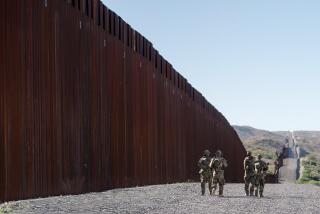1,000 Eskimo Rangers Form First Line of Defense for North America : Arctic: With toll-free telephone number at the ready, volunteers spread out across vast emptiness.
- Share via
POND INLET, Northwest Territories — The 1,000 Eskimos of Canada’s volunteer Arctic Rangers, armed with World War I rifles and a toll-free telephone number, are the first northern line of defense.
Spread out across the vast emptiness of the Yukon, Northwest Territories and northern Quebec, the Rangers are “the eyes and ears of the North,” said a military policy maker.
While Rangers hunt on the tundra and along Canada’s frigid coasts, as Eskimos have for centuries, they keep an eye peeled for suspicious or unusual activity.
Should a Russian nuclear submarine poke through the ice of some obscure northern bay, the Ranger would make for the nearest telephone and call an 800 number in Ottawa to report. That phone could be a long dog-sled or snowmobile ride away.
“We have photos of Soviet planes and ships,” said Jayko Alooloo, 42, corporal of the Ranger patrol in this tiny community on the northwestern end of Baffin Island, high above the Arctic Circle. “If we see one, we have to report it right away. We have a map to show where we saw it.
“We have a phone number and a pass number. That’s what we are volunteers for.”
Despite the end of the Cold War, the Rangers’ mission has not changed. Reconnaissance is needed even in peacetime, and they give Canadian soldiers vital training in arctic survival.
Whatever the intentions of the former Soviet republics, Canada cannot let down its guard while they are capable of attacking North America, Col. Hubert Leduc, assistant deputy defense minister for policy, said in an interview in Ottawa.
The Rangers serve as guides, advisers and survival instructors in military operations and exercises. They are a highly mobile reconnaissance force and also assist in ground search and rescue missions. Most are Inuit or Inuvialuit, the arctic tribes formerly known as Eskimos.
Dropping a quarter into a pay telephone hardly seems like nuclear-age defense, but Rangers also furnish visible proof of Canadian sovereignty in the region. That is important, particularly in the far northern archipelago, where even the American allies do not consider the waters exclusively Canadian.
Sheatie Tagak, a member of the 24-man Pond Inlet Ranger patrol for seven years, said he joined in order to help others.
“I was once lost for a week and I thought nobody was going to come and find me,” said Tagak, who works for the local cooperative store. “Somebody finally found me. So I thought, I want to be a Ranger and help people.”
It is something of an exclusive club and a status symbol for the men, who are proud to wear the distinctive red Ranger cap and fur-trimmed olive-drab jacket with the Ranger patch. There is always a waiting list to get in.
Above all, these men know the land. All are hunters of seal, walrus, polar bear, caribou and musk ox. The ice-bound land is their home. They are one with a land that is unforgiving to men from the south.
“We work with the army,” Alooloo said. “We teach them about survival up here, how to build a snow house, how to use hunting gear up here, and about the land.”
Each Ranger is issued a .303-caliber Lee-Enfield, a bolt-action rifle chosen for its reliability and small number of moving parts. Both qualities are important in weather that regularly drops to 40 below zero Fahrenheit.
They are paid $55 a day and gasoline for their snowmobiles when in training or on operations and receive 200 rounds of ammunition a year.
Training sessions are held annually at Yellowknife, the territorial capital, and there is a major exercise every two years.
The first-aid instruction is invaluable in a land with few doctors or nurses, and the Rangers reciprocate with survival training for Canadian soldiers.
“Essentially, a good hunter is a good Ranger,” Alooloo said. “Wherever we go, while hunting polar bear or caribou, we keep an eye out for anything unusual.”
The Rangers believe they play an important role, and Alooloo believes that it should be broadened.
“Rangers in the communities should be more involved with the Canadian army, not only with the ground troops, but with the pilots and the Canadian air force because our land up here is really hard,” he said.
Alooloo cited the crash of a Canadian Forces C-130 last fall near Alert on the far northern end of Ellesmere Island, virtually the top of the world.
A storm delayed rescuers for more than 30 hours and four people died. Alooloo said better training of air force personnel might have saved them.
“We Inuit are ready to help,” he said.
More to Read
Sign up for Essential California
The most important California stories and recommendations in your inbox every morning.
You may occasionally receive promotional content from the Los Angeles Times.













